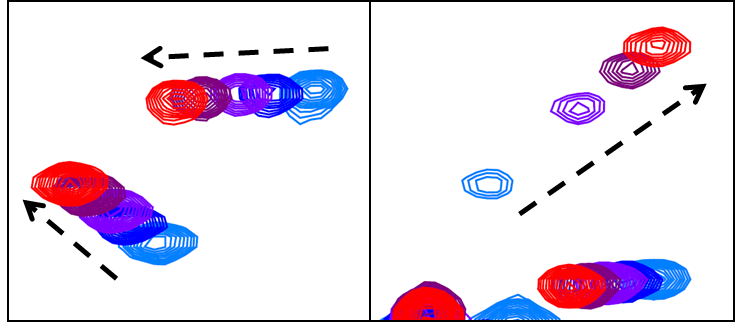Fay Probert
I graduated with a degree in mathematics from Warwick University in 2008. I then decided to join MOAC in order to have the opportunity to apply the skills I developed in the mathematics department to biological problems and develop a broader knowledge of chemistry, biology and bioinformatics. I completed my MSc with distinction in 2009.
I am currently a PhD student supervised by Dr Ann Dixon (Chemistry Department) and Dr Daniel Mitchell (Warwick Medical School). My research involves the use of solution state Nuclear Magnetic Resonance Spectroscopy (NMR) to investigate protein structure/dynamics and to study protein-carbohydrate interactions.
Current Research.
Structure-Function Analysis of the Carbohydrate Recognition Domain of the Human C-type Lectin DC-SIGNR via Solution NMR.
The C-type lectin DC-SIGNR (Dendritic Cell Specific ICAM3 Grabbing Non-integrin Related) has been shown to interact with a range of deadly diseases via specific glycosylation patterns on the surface of pathogenic glycoproteins. The ability of DC-SIGNR to increase the rate of infection of viruses such as human immunodeficiency virus (HIV) and hepatitis C virus (HCV) make the study of DC-SIGNR-oligosaccharide interactions very attractive. This project aims to use a combination of solution state heteronuclear NMR, surface plasmon resonance (SPR), isothermal titration calorimetry (ITC), and site-directed mutagenesis to develop a detailed understanding of the DC-SIGNR binding domain structure along with information on binding affinities, residues involved in binding, dynamics, and kinetics. It is hoped that an extensive knowledge of DC-SIGNR/oligosaccharide interactions will drive the development of novel antiviral drugs.
Techniques used:
-
Expression and purification of double labelled (N15/C13) protein for NMR.
-
Characterisation of proteins by MALDI Mass Spectrometry, and Circular Dichroism.
-
2D NMR (including HSQC experiments) for ligand titration studies.
-
Triple resonance NMR experiments for protein assignment and structural determination.
-
The use of various NMR processing packages and structure calculation programmes (including, Bruker Topspin, SPARKY, CCPN, CYANA, NMRpipe, TALOS+).
-
Mutagenesis.
-
Surface Plasmon Resonance (SPR).
-
Isothermal Titration Calorimetry (ITC).

Studentships and Awards.
| 2012 |
1st place presentation prize,Chemistry Postgraduate Symposium, University of Warwick. |
2nd place poster prize,MOAC annual conference. |
|
| 2011 |
1st place poster prize,Chemistry Postgraduate Symposium, University of Warwick. |
| 2010 |
1st place PhD poster prize,MOAC annual conference. |
| 2009 |
1st place MSc poster prize,MOAC annual conference. |
| 2008-2012 |
Engineering and Physical Sciences Research Council (EPSRC) Studentship |
| 2005-2008 |
Undergraduate Studies Scholarship, University of Warwick. |
Conferences.
| 2012 |
Midlands Biophysics Symposium,Aston University. |
|
Talk: A Structure and Function Study of DC-SIGNR by Solution NMR. |
|
Euromar,Dublin, Ireland. |
|
Chemistry Postgraduate Symposium,Warwick University. (Talk) |
|
MOAC Annual Conference.(Poster) |
|
| 2011 |
11th CCPN Conference,University of Hull. (Poster) |
EUROMAR,Frankfurt, Germany. (Poster) |
|
West Midlands Biophysics Symposium,Warwick University. (Poster) |
|
Chemistry Postgraduate Symposium,Warwick University. (Poster) |
|
MOAC Annual Conference,Arnside. (Poster) |
|
| 2010 |
West Midlands Biophysics Symposium,University of Leicester. |
MOAC Annual Conference,Arnside. (Poster) |
|
| 2009 |
MOAC Annual Conference,Langdale. (Poster & Talk) |
Previous Research.
The MOAC MSc involves three separate 8 week research projects each in a different discipline. These projects allowed me to gain valuable experience in Chemistry, Biology and Statistics.
Antibiotic peptides and their interactions with lipid membranes
Supervisor: Matthew Hicks
During this project I gained experience using a range of biophysical techniques: Circular Dichroism (CD), Linear Dichroism (LD), and Dynamic Light Scattering (DLS) to study the insertion of antibiotic aurein peptides in a variety of model membranes.
Modelling of dose-response studies for novel organometallic anticancer complexes
Supervisor: Fabio Rigat
This project utilised Bayesian statistics to develop a dose-response model for a novel class of platinum based anticancer complexes developed by the Sadler group.
Using FRET to study the dynamics and biological function of PDIp
Supervisors: Robert Freedman and Katrine Wallis
During this project I successfully expressed, purifyed and fluorescently taged the protein PDIp with the long term goal of carrying out single molecule FRET to investigate the dynamics of the active site.
![[Photo of Fay Probert]](picofme.jpg?maxWidth=281&maxHeight=403)
Contact Details:
MOAC Centre
Coventry House
University of Warwick
Coventry
CV4 7AL
EMAIL: F.Probert@warwick.ac.uk
